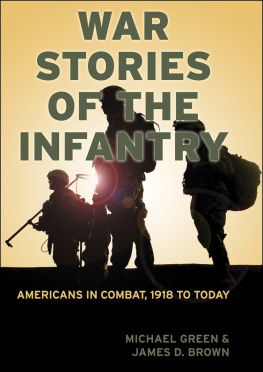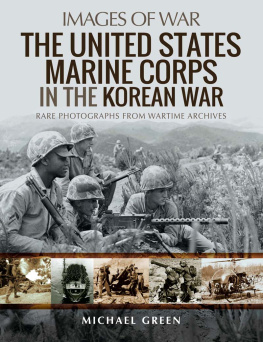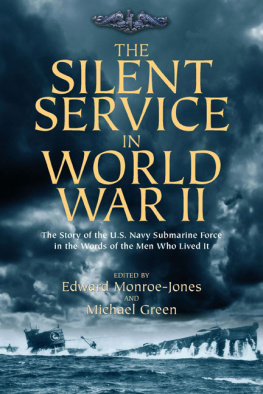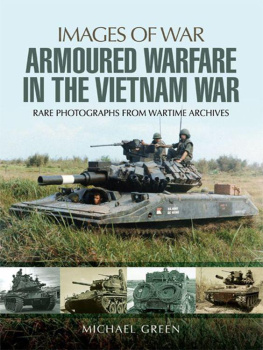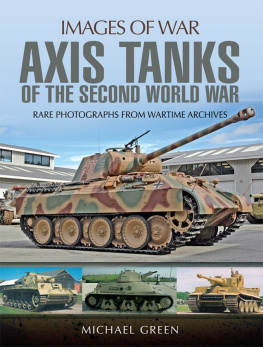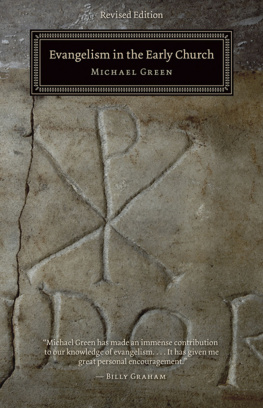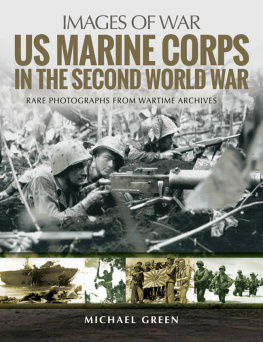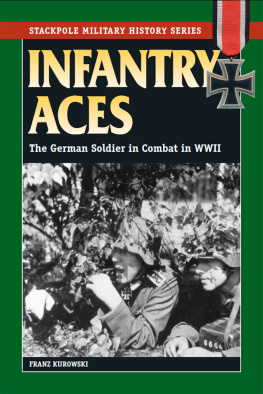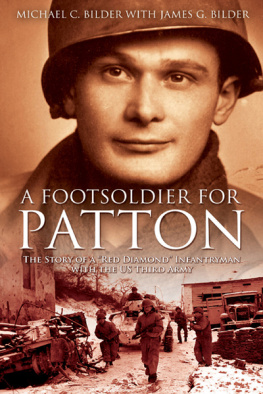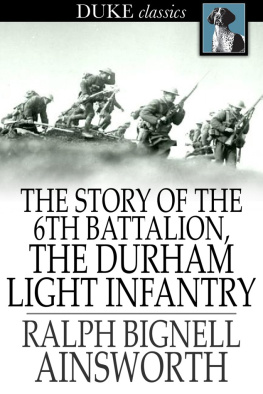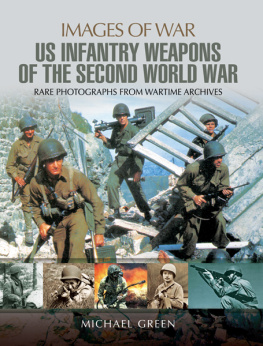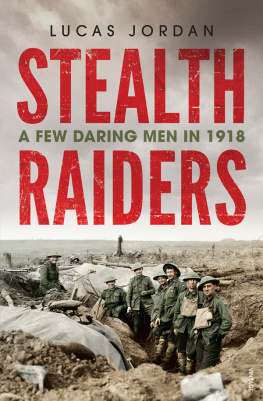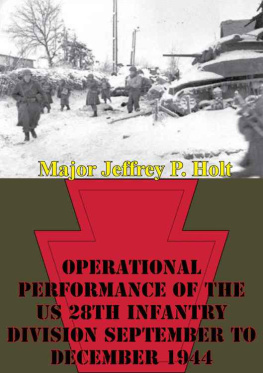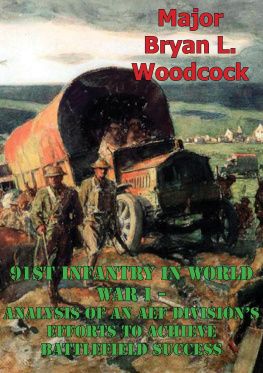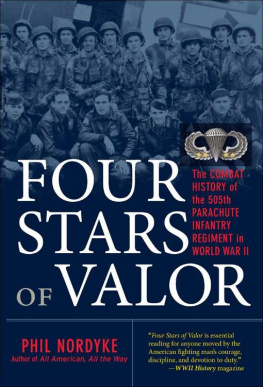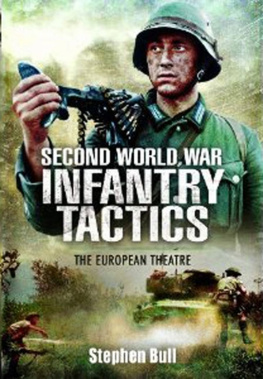ACKNOWLEDGMENTS
Besides those individuals stories that appear in this book, the authors would like to thank the following persons for their help in providing the contact points for many of the interviews found within this work. These include Jonathan P. Roth, Jennifer K. Yancey, Elsie Jackson, Ericka I. Loze-Hudson, Jason Toepher, William Castle, Michael E. Hanlon, Kenneth W. Estes, Fred Allison, Virgil Roberts, and Martin W. Anderson.
Thanks also go to Charles Merrill for the transcribing and giving permission to use the World War I war story of Sgt. Charles Leo Boucher. The same appreciation goes out to Kim Kovaril for the editing of the World War II war story of Pvt. Ed Poppendick and for Sharon Hutto Marks for transcribing her fathers, Staff Sgt. James C. Buck Hutto, World War II war story and for allowing the authors permission for use of it in this work.
A special note of thanks goes to the Korean War Educator, a nonprofit educational group dedicated to preserving the history of the Korean War online. Mrs. Dale M. (Lynnita) Brown who maintains a website at www.koreanwar-educator.org heads the organization.
Organizations that provided help in collecting stories for this book include the U.S. Army National Infantry Museum, the Media Relation branch of the Fort Benning Public Affairs Office, Infantry magazine, the Donovan Research Library, and the U.S. Army Office of the Chief of Public Affairs (New York Branch). Other organizations that provided support for the authors include the Marine Corps University (History Division), the U.S. Army Heritage and Education Center, and the Great War Society.
INTRODUCTION
Every Marine is, first and foremost, a rifleman. All other conditions are secondary.
Gen. Alfred M. Gray,
29th Marine Corps Commandant (19871991)
Our literature is replete with military histories; stories of conquests made and empires expanded or lost, of political, economic, social, or religious goals achieved or failed. Such accounts are told not only in text, but in the pictorial language of maps recolored and redrawn, and of boldly swooping arrows tracing the progress of campaigns across countries and continents. Their military forces are depicted as so many game pieces deployed across irregular and multicolored chessboards. This isnt one of those books.
These accounts werent set down by men who write history; they are the words of men who made history. The infantrymen, whose stories these are, were at the cutting edge of the arrows you have already seen drawn across the maps. Theirs are not the tales of countries conquered, but of farmers fields crossed under fire dragging a wounded buddy. Their victories were not of cities captured or fortresses reduced, but of machine-gun bunkers silenced and hedgerows crossed.
War is a terrible undertaking, and infantrymen bear the worst of it. Artillerymen, aviators, cavalrymen, and tankers see our share of the terrors of combat, but anybody whos ever been in a fight will tell you that the infantry always has it the toughest.
An infantryman knows more than one treatment for malaria, and can state his personal preference. He knows why you crawl through the jungle alongside a trail instead of walking along it. An infantryman knows why that rock out in the clearing looked like it was crawling closer to his foxhole last night. And he knows that no foxhole is ever deep enough to protect him from that one-in-a-million mortar round that has his name on it.
A common thread running through these stories is that almost none of these guys started out trying to be a hero, and even fewer ended up trying to be one. They were sons of Iowa farmers and New Jersey grocers, and Texas ranchers, who were just trying to do their duty and keep alive in the process.
Some of the stories start with accounts of how these boys joined the U.S. Army or Marine Corps with visions of sharp uniforms, travel and adventure, steady pay, and barracks room camaraderie, but none of that lasts even as far as their second paragraphs. An infantrymans life is hard enough in training, but once the fighting starts, its all downhill from there. What you do see is that all these boys fought not so much for the high ideals of soldiery as for each other. Although family and friends back home are treasured memories, every soldiers world soon shrinks to encompass his fellows in the platoon, the company, the battalion. Unlike the red-shirted, and hence nameless and expendable, members of a Star Trek away team, every soldier in a unit in combat is a brother to every other. Losses are keenly felt, and men now dead for decades past are still remembered in these mens thoughts and prayers.
What is even more remarkable in these stories is that they are even remembered at all. Most of us will be fortunate enough to not see even one violent death in our entire lifetimes. These men have seen comrades fall as a daily occurrence. No one could fault them if they just blotted these events out of their memory, as a kind of psychological self-defense. Most of them, however, remember their experiences as if they happened yesterday. Not everything... just the important stuff. They may not remember what month it was, but they can remember the last conversation they had just before a buddy died in a first-aid station in a World War I battle. They cant always remember exactly which hill they were defending, but they remember exactly how many Browning automatic rifle (BAR) magazines were in the bandolier they carried up to the last remaining dugout in Korea. They might not even know whether they were in Germany or Belgium, but they remember the name of that sergeant from Texas who got shot by a sniper in the tree line across the road. They remember the important stuff, like never letting your buddies down when they need you.
The editors have resisted the temptation to pretty up the language of these stories. The sentence structure and grammar may not always be right, but we think its more important for you, the reader, to hear their stories in their words. We have changed the narratives only where absolutely necessary for clarity, and then made the least editorial intrusion we could. It is our hope that you will receive these imperfections as proof of their authenticity. The stories themselves come from a wide variety of different sources, including interviews, after-actions reports, unit histories, Infantry magazine, and written memoirs.
Each story reflects the perspective of the individual and his position in the military and his rank at the time the story or stories took place. Obviously, officers often have a much different view of combat than those of the enlisted personnel as is apparent in the stories found within this book. Many of the stories are horrific and reflect the nature of war. Most provide examples of infantrymen overcoming various obstacles, be it the enemy, the terrain, the weather, and doing their duty as American fighting men.




